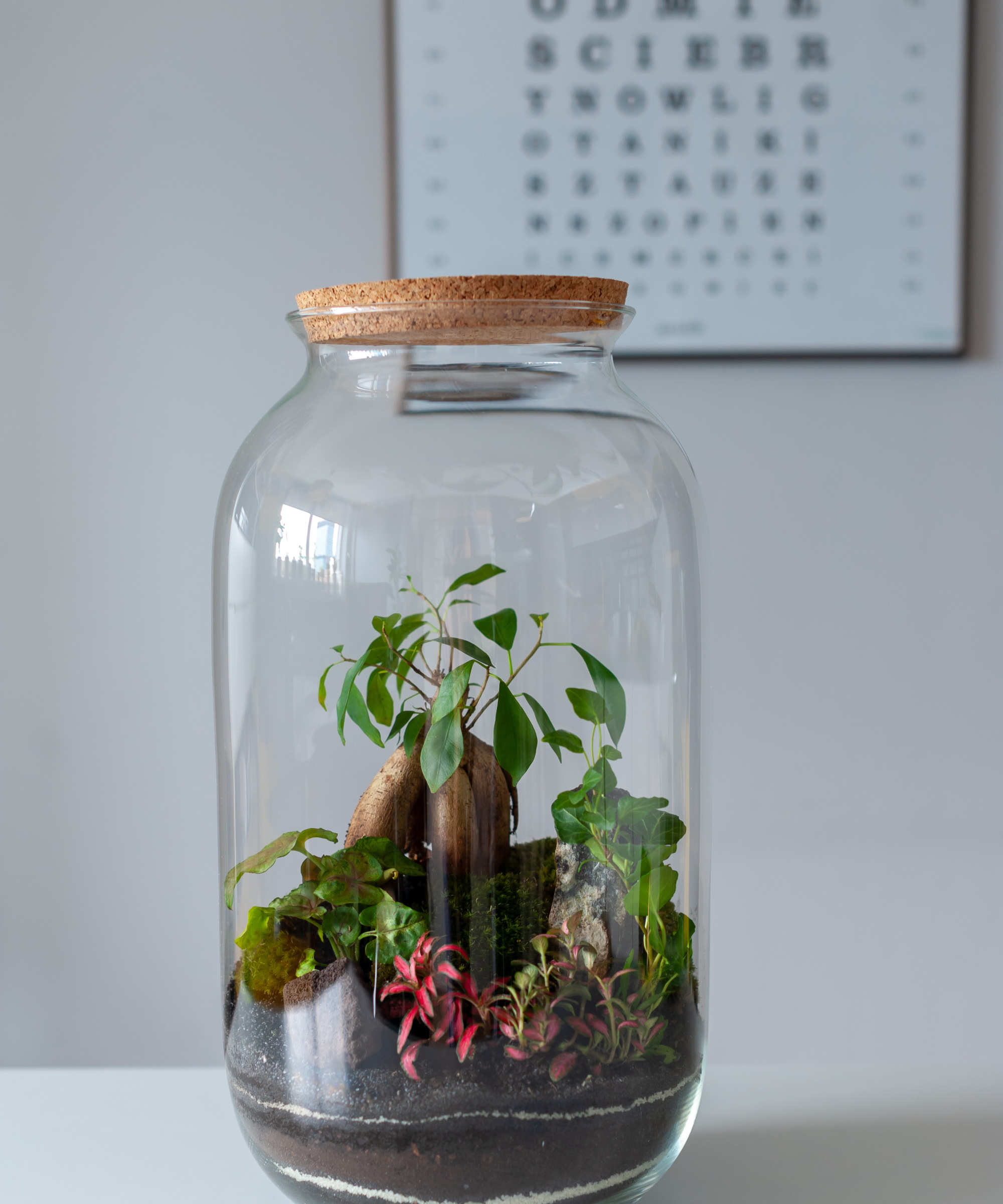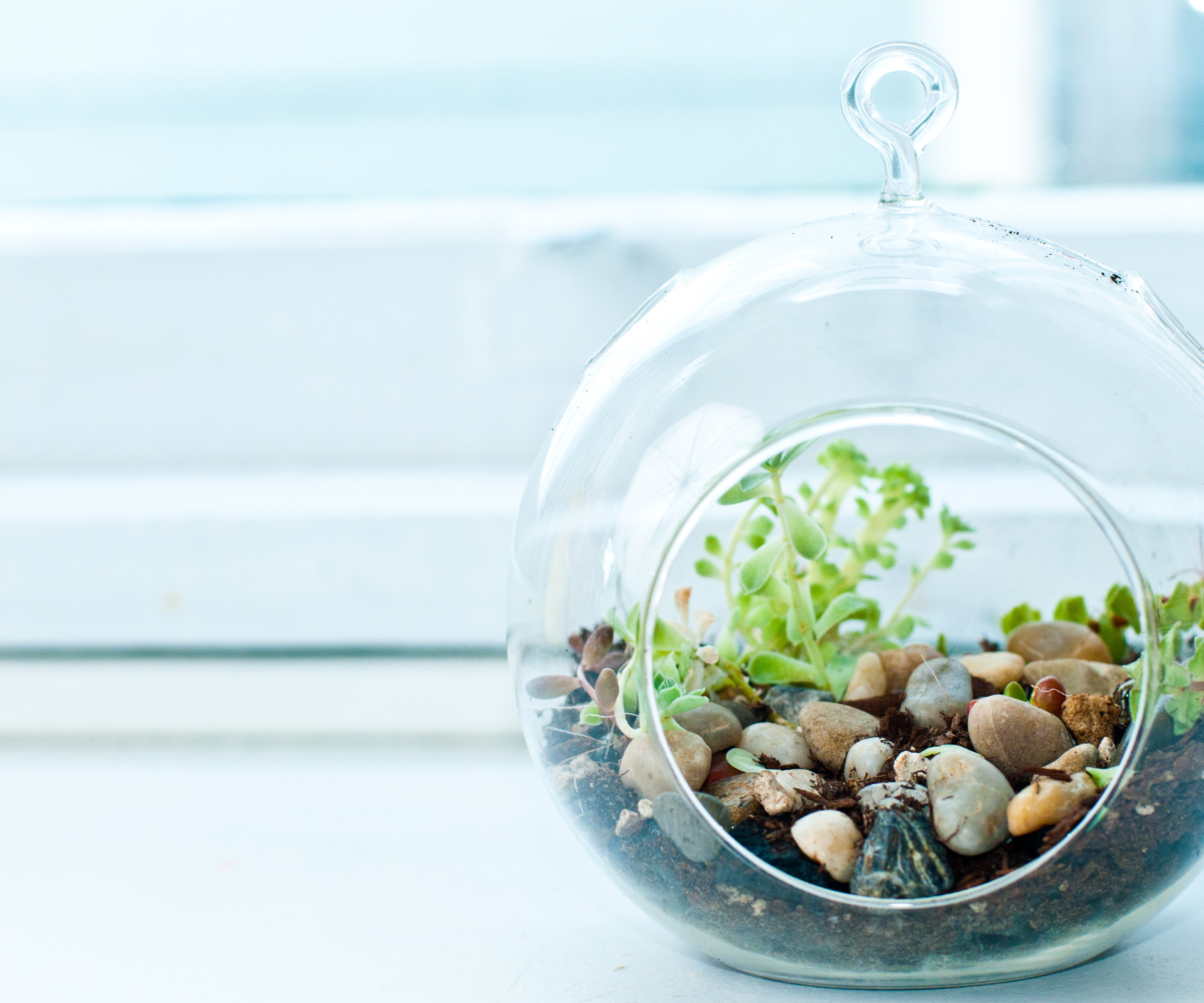The top 5 terrarium care mistakes you need to avoid, according to houseplant experts
Our expert tips on terrarium care mistakes show just how easy it is to keep your terrarium looking good as long as you avoid these common pitfalls


Although terrariums are a low-maintenance option and require less attention than many houseplants, they do require some TLC every now and then to keep them healthy. Plus, there are some key mistakes to avoid if you want them to remain looking their best.
Terrariums will often look after themselves once planted. Especially if you choose a closed design, which will create its own self-watering mini ecosystem. You can't beat them if you're looking for as easy option. Just avoid the common pitfall of planting and caring for succulents in a closed design as conditions will be too humid for them and they won't thrive.
Where you keep your terrarium is also key to its success. Look into the light requirements of each of the terrarium plants you have in mind before choosing your winning combination and you will be on your way to hitting a successful formula.
The 5 most common terrarium care mistakes (and how to avoid them)
You've invested time, effort and money into the indoor plants in your terrarium and want it to stay looking good for the long haul. Follow our expert tips on what not to do if you want your terrarium to continue thriving.
1. Putting the terrarium in the wrong place

Keeping the terrarium in the right spot is important, so be sure yours will fit in the position you have in mind when planning your design. Closed terrariums prefer bright, indirect light, while open ones like a well-lit spot that's not in direct sunlight. Again check out the requirements of the plants you have in mind.
'Plants in airtight or closed terrariums recycle air,' explains Matt Kostelnick, senior horticulturist at Ambius. 'During the day, sunlight promotes the growth of sugars during the process of photosynthesis, which converts carbon dioxide into oxygen, releasing it into the terrarium.' You may want to remove the lid of a closed terrarium every now and then to let in some fresh air as part of your terrarium care routine.
2. Watering your terrarium incorrectly

When it comes to watering plants in terrariums it depends on how many plants you have included in your scheme and what type they are, as well as whether or not your terrarium is an open or closed design. Remember also that terrariums retain water for longer than most other houseplants.
Design expertise in your inbox – from inspiring decorating ideas and beautiful celebrity homes to practical gardening advice and shopping round-ups.
Terrariums don't need watering as much as many other indoor plants. 'The types of plants found in terrariums tend to be hardy plants that don’t require frequent watering,' says Matt Kostelnick. 'Also, the greenhouse-like structure of terrariums recycles water instead of evaporating.'
If your terrarium is closed it requires little or no watering, as it maintains the right level of humidity so becomes self-watering. You should be able to see condensation up to a third of the height of the terrarium. If there's very little condensation, try adding a tablespoon of water.
If the soil is completely dry and the leaves are wilting this is a sign that the terrarium needs watering. On average, if you have a closed terrarium you might need to water it once a month but if in doubt always water less.
'Open terrariums benefit from being watered every 3-6 weeks,' says Matt. 'Rather than watering on a schedule, check the soil to see if and how much water your plants actually need.'
If you have a plant-heavy terrarium it will need to be watered more regularly. Make sure it's not in direct sunlight too, as this can lead to the soil drying out. Use a terrarium water bottle like this one from Amazon with a bendable nozzle to help get the water directed to exactly where it's needed.

Matt Kostelnick is a senior horticulturist at Ambius. Known by many as 'The Plant Doctor', he has over 20 years of combined experience in the horticulture industry and teaching horticulture at university level.
3. Failing to trim terrarium plants

Pruning terrarium plants can be tricky due to the enclosed nature of the space and density of planting. You will need to trim back any plants that touch the sides of the terrarium or have grown so tall they are reaching the top. It's worth investing in a special set of extra long aquarium tools (available from Amazon) including scissors and tweezers that are perfect for the job.
Use your new tools to keep leggy plants under control if you see them crowding the sides or top of the terrarium. Cut straggly stems down to a healthy leaf joint to encourage fuller growth.
Regularly trim any yellowing or dried leaves to keep the plants in your terrarium looking good. If you added a decorative layer of moss and it's looking a little jaded add a tablespoon of water every now and then to green it up.
If one of your plants is in trouble, there's no point holding on to it in the hope it will rally. If it's diseased this could spread to others in your indoor planter, plus of course it will detract from the aesthetics of your terrarium. When removing an ailing plant, be careful not disturb the roots of other plants. If you replace it with a new plant, it will need to be similar in size to slot neatly into your design.
4. Letting the terrarium glass get dirty
If the glass is too dirty or foggy, it will prevent light from reaching your plants which can be detrimental to their health.
Regularly dusting the outside is an important part of terrarium care as this allows light in, as well as showing off your plants. Either moisten a paper towel or use a soft clean cloth to simply wipe the glass. Avoid using glass cleaners as these may container chemicals that will be detrimental to your plants.
When cleaning the inside of the terrarium use distilled water or better still collected rainwater with a soft lint-free cloth. You only need the tiniest amount of water. Do not use a cleaning solution as that could contain chemicals that might be harmful to plants.
While you're there, don't forget to clean houseplants in your terrarium too.
5. Failing to act quickly if the terrarium gets bugs

If you have an open terrarium, monitor regularly for pests as part of your terrarium care. 'Gnats, mites, and mealybugs are all known plant parasites that can hitch a ride into terrariums via plants and substrate,' explains plant expert Dan Jones of Terrarium Tribe.
If you think there's a problem take action immediately. Plants for terrariums aren't expensive and keeping a plant with an infestation in a terrarium means it could easily spread to other plants.
'We recommend buying insecticidal soap [available from Amazon] and applying it to infected plants,' says Matt Kostelnick. 'You can also buy pebbles or rocks to deter gnats and avoid overwatering.' Check at your local gardening store for more advice.
If all else fails and the plant is still infested, the best terrarium care is to remove the entire plant. The same principal can be applied to your other easy indoor plants too – don't let one ailing plant spoil your display.

Dan is the founder of Terrarium Tribe and its resident plant daddy. As a former research scientist turned writer, he loves to blend the art and science of horticulture.
FAQs
Are terrariums easy to care for?
Terrariums are easy to care for but there are one or two key considerations to take into account if you want to make sure yours is a long lasting and healthy centerpiece of your indoor plants.
'It's important to regularly monitor and care for the plants in a terrarium, including watering, pruning, and providing adequate light and ventilation,' says James Kinsella from horticulture and botanical research experts Outplanted.com. 'Overall, plants grow well in a terrarium as long as you give them the right conditions.'
Though not the only plant to grow in a terrarium, the different types of succulents can be the perfect picks, though they come with their own set of growing and care mistakes, and you'll particularly find that watering succulents correctly is key to ensuring your terrarium plants stay looking healthy.

Lifestyle journalist Sarah Wilson writes about garden design and landscaping trends for Homes & Gardens. She has studied introductory garden and landscape design, and also has an RHS Level 2 qualification in the Principles of Plant Growth and Development. She is a regular contributor to Homes & Gardens and Livingetc. She has also written for Country Living, Country Homes & Interiors, and Modern Gardens magazines